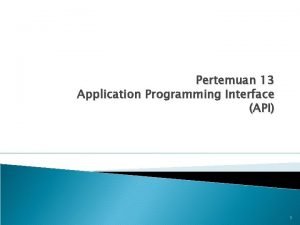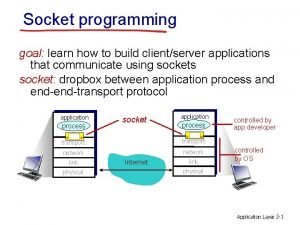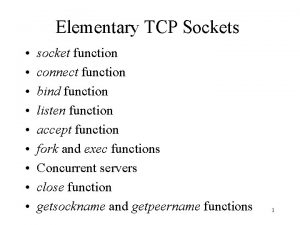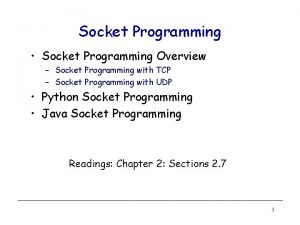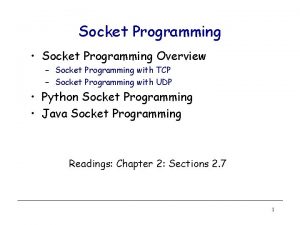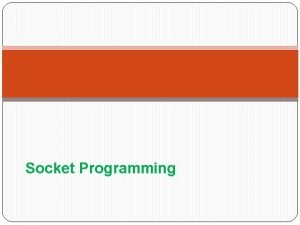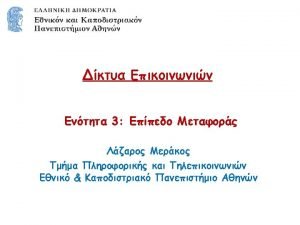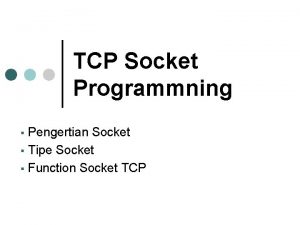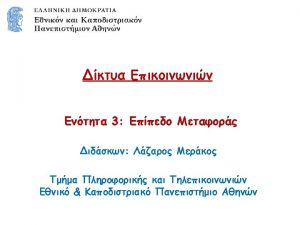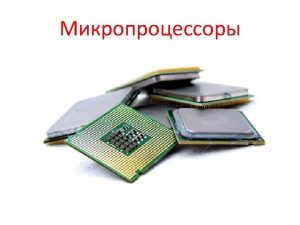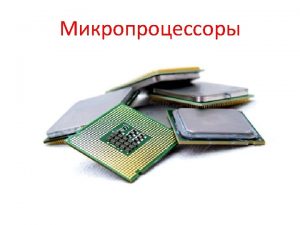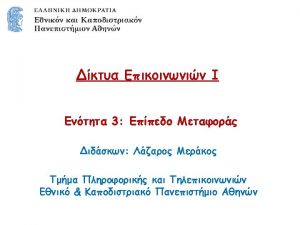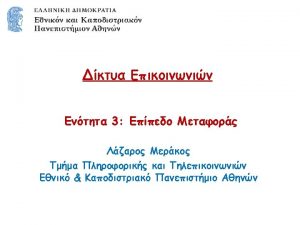Socket Programming Application Programming Interface Application Programming Interface
















- Slides: 16

Socket Programming Application Programming Interface

Application Programming Interface • Interface exported by the network • Since most network protocols are implemented (those in the high protocol stack) in software and nearly all computer systems implement their network protocols as part of the operating system, when we refer to the interface “exported by the network”, we are generally referring to the interface that the OS provides to its networking subsystem • The interface is called the network Application Programming Interface (API)

Application Programming Interface (Sockets) • Socket Interface was originally provided by the Berkeley distribution of Unix - Now supported in virtually all operating systems • Each protocol provides a certain set of services, and the API provides a syntax by which those services can be invoked in this particular OS

Socket • What is a socket? – The point where a local application process attaches to the network – An interface between an application and the network – An application creates the socket • The interface defines operations for – – Creating a socket Attaching a socket to the network Sending and receiving messages through the socket Closing the socket

Socket • Socket Family – PF_INET denotes the Internet family – PF_UNIX denotes the Unix pipe facility – PF_PACKET denotes direct access to the network interface (i. e. , it bypasses the TCP/IP protocol stack) • Socket Type – SOCK_STREAM is used to denote a byte stream – SOCK_DGRAM is an alternative that denotes a message oriented service, such as that provided by UDP

Creating a Socket int sockfd = socket(address_family, type, protocol); • The socket number returned is the socket descriptor for the newly created socket • int sockfd = socket (PF_INET, SOCK_STREAM, 0); • int sockfd = socket (PF_INET, SOCK_DGRAM, 0); The combination of PF_INET and SOCK_STREAM implies TCP

Client-Serve Model with TCP Server – Passive open – Prepares to accept connection, does not actually establish a connection Server invokes int bind (int socket, struct sockaddr *address, int addr_len) int listen (int socket, int backlog) int accept (int socket, struct sockaddr *address, int *addr_len)

Client-Serve Model with TCP Bind – Binds the newly created socket to the specified address i. e. the network address of the local participant (the server) – Address is a data structure which combines IP and port Listen – Defines how many connections can be pending on the specified socket

Client-Serve Model with TCP Accept – Carries out the passive open – Blocking operation • Does not return until a remote participant has established a connection • When it does, it returns a new socket that corresponds to the new established connection and the address argument contains the remote participant’s address

Client-Serve Model with TCP Client – Application performs active open – It says who it wants to communicate with Client invokes int connect (int socket, struct sockaddr *address, int addr_len) Connect – Does not return until TCP has successfully established a connection at which application is free to begin sending data – Address contains remote machine’s address

Client-Serve Model with TCP In practice – The client usually specifies only remote participant’s address and let’s the system fill in the local information – Whereas a server usually listens for messages on a well-known port – A client does not care which port it uses for itself, the OS simply selects an unused one

Client-Serve Model with TCP Once a connection is established, the application process invokes two operation int send (int socket, char *msg, int msg_len, int flags) int recv (int socket, char *buff, int buff_len, int flags)

Example Application: Client #include <stdio. h> #include <sys/types. h> #include <sys/socket. h> #include <netinet/in. h> #include <netdb. h> #define SERVER_PORT 5432 #define MAX_LINE 256 int main(int argc, char * argv[]) { FILE *fp; struct hostent *hp; struct sockaddr_in sin; char *host; char buf[MAX_LINE]; int s; int len; if (argc==2) { host = argv[1]; } else { fprintf(stderr, "usage: simplex-talk hostn"); exit(1); }

Example Application: Client /* translate host name into peer’s IP address */ hp = gethostbyname(host); if (!hp) { fprintf(stderr, "simplex-talk: unknown host: %sn", host); exit(1); } /* build address data structure */ bzero((char *)&sin, sizeof(sin)); sin_family = AF_INET; bcopy(hp->h_addr, (char *)&sin. sin_addr, hp->h_length); sin_port = htons(SERVER_PORT); /* active open */ if ((s = socket(PF_INET, SOCK_STREAM, 0)) < 0) { perror("simplex-talk: socket"); exit(1); } if (connect(s, (struct sockaddr *)&sin, sizeof(sin)) < 0) { perror("simplex-talk: connect"); close(s); exit(1); } /* main loop: get and send lines of text */ while (fgets(buf, sizeof(buf), stdin)) { buf[MAX_LINE-1] = ’�’; len = strlen(buf) + 1; send(s, buf, len, 0); } }

Example Application: Server #include <stdio. h> #include <sys/types. h> #include <sys/socket. h> #include <netinet/in. h> #include <netdb. h> #define SERVER_PORT 5432 #define MAX_PENDING 5 #define MAX_LINE 256 int main() { struct sockaddr_in sin; char buf[MAX_LINE]; int len; int s, new_s; /* build address data structure */ bzero((char *)&sin, sizeof(sin)); sin_family = AF_INET; sin_addr. s_addr = INADDR_ANY; sin_port = htons(SERVER_PORT); /* setup passive open */ if ((s = socket(PF_INET, SOCK_STREAM, 0)) < 0) { perror("simplex-talk: socket"); exit(1); }

Example Application: Server if ((bind(s, (struct sockaddr *)&sin, sizeof(sin))) < 0) { perror("simplex-talk: bind"); exit(1); } listen(s, MAX_PENDING); /* wait for connection, then receive and print text */ while(1) { if ((new_s = accept(s, (struct sockaddr *)&sin, &len)) < 0) { perror("simplex-talk: accept"); exit(1); } while (len = recv(new_s, buf, sizeof(buf), 0)) fputs(buf, stdout); close(new_s); } }
 A socket is an interface between
A socket is an interface between Bsd socket programming
Bsd socket programming Interface yang digambarkan dengan bentuk socket adalah
Interface yang digambarkan dengan bentuk socket adalah Contoh application programming interface
Contoh application programming interface Papi_start_counters
Papi_start_counters Socket programming in c
Socket programming in c Tcp udp socket programming in java
Tcp udp socket programming in java Welcoming socket
Welcoming socket Bind function in socket programming
Bind function in socket programming Gqoute
Gqoute What is socket
What is socket R socket programming
R socket programming What is system programing
What is system programing What is interface in java
What is interface in java User led through interaction via series of questions
User led through interaction via series of questions Office interface vs industrial interface
Office interface vs industrial interface An interface
An interface



